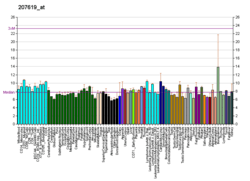Hypocretin (orexin) receptor 1
Orexin receptor type 1 (Ox1R or OX1), also known as hypocretin receptor type 1 (HcrtR1), is a protein that in humans is encoded by the HCRTR1 gene.[5]
Function
The orexin 1 receptor (OX1), is a G-protein coupled receptor that is heavily expressed in projections from the lateral hypothalamus and is involved in the regulation of feeding behaviour. OX1 selectively binds the orexin-A neuropeptide. It shares 64% identity with OX2.[5]
Ligands
Agonists
Antagonists
- RTIOX-276 - Selective OX1 antagonist
- ACT-335827 - Selective OX1 antagonist
- Almorexant - Dual OX1 and OX2 antagonist
- Lemborexant - Dual OX1 and OX2 antagonist[6]
- SB-334,867 - Selective OX1 antagonist
- SB-408,124 - Selective OX1 antagonist
- SB-649,868 - Dual OX1 and OX2 antagonist
- Suvorexant - Dual OX1 and OX2 antagonist
See also
References
- 1 2 3 GRCh38: Ensembl release 89: ENSG00000121764 - Ensembl, May 2017
- 1 2 3 GRCm38: Ensembl release 89: ENSMUSG00000028778 - Ensembl, May 2017
- ↑ "Human PubMed Reference:".
- ↑ "Mouse PubMed Reference:".
- 1 2 "Entrez Gene: HCRTR1 hypocretin (orexin) receptor 1".
- ↑ http://www.marketwatch.com/story/eisai-demonstrates-efficacy-of-investigational-dual-orexin-receptor-antagonist-e2006-in-sleep-initiation-and-maintenance-data-from-phase-ii-clinical-trial-for-insomnia-2014-12-10. Missing or empty
|title=(help)
External links
- "Orexin Receptors: OX1". IUPHAR Database of Receptors and Ion Channels. International Union of Basic and Clinical Pharmacology.
Further reading
- Flier JS, Maratos-Flier E (Feb 1998). "Obesity and the hypothalamus: novel peptides for new pathways". Cell. 92 (4): 437–40. PMID 9491885. doi:10.1016/S0092-8674(00)80937-X.
- Willie JT, Chemelli RM, Sinton CM, Yanagisawa M (2001). "To eat or to sleep? Orexin in the regulation of feeding and wakefulness". Annual Review of Neuroscience. 24: 429–58. PMID 11283317. doi:10.1146/annurev.neuro.24.1.429.
- Hungs M, Mignot E (May 2001). "Hypocretin/orexin, sleep and narcolepsy". BioEssays. 23 (5): 397–408. PMID 11340621. doi:10.1002/bies.1058.
- de Lecea L, Kilduff TS, Peyron C, Gao X, Foye PE, Danielson PE, Fukuhara C, Battenberg EL, Gautvik VT, Bartlett FS, Frankel WN, van den Pol AN, Bloom FE, Gautvik KM, Sutcliffe JG (Jan 1998). "The hypocretins: hypothalamus-specific peptides with neuroexcitatory activity". Proceedings of the National Academy of Sciences of the United States of America. 95 (1): 322–7. PMC 18213
 . PMID 9419374. doi:10.1073/pnas.95.1.322.
. PMID 9419374. doi:10.1073/pnas.95.1.322. - Sakurai T, Amemiya A, Ishii M, Matsuzaki I, Chemelli RM, Tanaka H, Williams SC, Richardson JA, Kozlowski GP, Wilson S, Arch JR, Buckingham RE, Haynes AC, Carr SA, Annan RS, McNulty DE, Liu WS, Terrett JA, Elshourbagy NA, Bergsma DJ, Yanagisawa M (Feb 1998). "Orexins and orexin receptors: a family of hypothalamic neuropeptides and G protein-coupled receptors that regulate feeding behavior" (PDF). Cell. 92 (4): 573–85. PMID 9491897. doi:10.1016/S0092-8674(00)80949-6.
- Sakurai T, Amemiya A, Ishii M, Matsuzaki I, Chemelli RM, Tanaka H, Williams SC, Richarson JA, Kozlowski GP, Wilson S, Arch JR, Buckingham RE, Haynes AC, Carr SA, Annan RS, McNulty DE, Liu WS, Terrett JA, Elshourbagy NA, Bergsma DJ, Yanagisawa M (Mar 1998). "Orexins and orexin receptors: a family of hypothalamic neuropeptides and G protein-coupled receptors that regulate feeding behavior". Cell. 92 (5): 1 page following 696. PMID 9527442. doi:10.1016/S0092-8674(02)09256-5.
- Peyron C, Faraco J, Rogers W, Ripley B, Overeem S, Charnay Y, Nevsimalova S, Aldrich M, Reynolds D, Albin R, Li R, Hungs M, Pedrazzoli M, Padigaru M, Kucherlapati M, Fan J, Maki R, Lammers GJ, Bouras C, Kucherlapati R, Nishino S, Mignot E (Sep 2000). "A mutation in a case of early onset narcolepsy and a generalized absence of hypocretin peptides in human narcoleptic brains". Nature Medicine. 6 (9): 991–7. PMID 10973318. doi:10.1038/79690.
- Blanco M, López M, GarcIa-Caballero T, Gallego R, Morel G, SeñarIs R, Casanueva F, Diéguez C, Beiras A (Jul 2001). "Cellular localization of orexin receptors in human pituitary". The Journal of Clinical Endocrinology and Metabolism. 86 (7): 1616–9. PMID 11443222. doi:10.1210/jc.86.7.3444.
- Olafsdóttir BR, Rye DB, Scammell TE, Matheson JK, Stefánsson K, Gulcher JR (Nov 2001). "Polymorphisms in hypocretin/orexin pathway genes and narcolepsy". Neurology. 57 (10): 1896–9. PMID 11723285. doi:10.1212/wnl.57.10.1896.
- Wieland HA, Söll RM, Doods HN, Stenkamp D, Hurnaus R, Lämmle B, Beck-Sickinger AG (Feb 2002). "The SK-N-MC cell line expresses an orexin binding site different from recombinant orexin 1-type receptor". European Journal of Biochemistry / FEBS. 269 (4): 1128–35. PMID 11856342. doi:10.1046/j.0014-2956.2001.02739.x.
- Hilairet S, Bouaboula M, Carrière D, Le Fur G, Casellas P (Jun 2003). "Hypersensitization of the Orexin 1 receptor by the CB1 receptor: evidence for cross-talk blocked by the specific CB1 antagonist, SR141716". The Journal of Biological Chemistry. 278 (26): 23731–7. PMID 12690115. doi:10.1074/jbc.M212369200.
- Karteris E, Chen J, Randeva HS (Apr 2004). "Expression of human prepro-orexin and signaling characteristics of orexin receptors in the male reproductive system". The Journal of Clinical Endocrinology and Metabolism. 89 (4): 1957–62. PMID 15070969. doi:10.1210/jc.2003-031778.
- Holmqvist T, Johansson L, Ostman M, Ammoun S, Akerman KE, Kukkonen JP (Feb 2005). "OX1 orexin receptors couple to adenylyl cyclase regulation via multiple mechanisms". The Journal of Biological Chemistry. 280 (8): 6570–9. PMID 15611118. doi:10.1074/jbc.M407397200.
- Spinazzi R, Rucinski M, Neri G, Malendowicz LK, Nussdorfer GG (Jun 2005). "Preproorexin and orexin receptors are expressed in cortisol-secreting adrenocortical adenomas, and orexins stimulate in vitro cortisol secretion and growth of tumor cells". The Journal of Clinical Endocrinology and Metabolism. 90 (6): 3544–9. PMID 15797953. doi:10.1210/jc.2004-2385.
- Meerabux J, Iwayama Y, Sakurai T, Ohba H, Toyota T, Yamada K, Nagata R, Irukayama-Tomobe Y, Shimizu H, Yoshitsugu K, Ohta K, Yoshikawa T (Sep 2005). "Association of an orexin 1 receptor 408Val variant with polydipsia-hyponatremia in schizophrenic subjects". Biological Psychiatry. 58 (5): 401–7. PMID 15978554. doi:10.1016/j.biopsych.2005.04.015.
- Ziolkowska A, Spinazzi R, Albertin G, Nowak M, Malendowicz LK, Tortorella C, Nussdorfer GG (Sep 2005). "Orexins stimulate glucocorticoid secretion from cultured rat and human adrenocortical cells, exclusively acting via the OX1 receptor". The Journal of Steroid Biochemistry and Molecular Biology. 96 (5): 423–9. PMID 16157481. doi:10.1016/j.jsbmb.2005.05.003.
This article incorporates text from the United States National Library of Medicine, which is in the public domain.
This article is issued from
Wikipedia.
The text is licensed under Creative Commons - Attribution - Sharealike.
Additional terms may apply for the media files.




